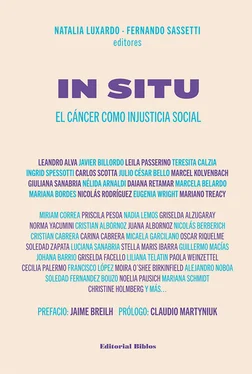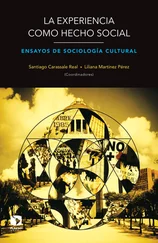IERULLO, M. (2015), “La crianza de niños, niñas y adolescentes en contextos de pobreza urbana persistente”, Revista Latinoamericana de Ciencias Sociales, Niñez y Juventud , 13 (2): 671-683.
INSTITUTO NACIONAL DEL CÁNCER (2018), Plan Nacional de Control de Cáncer. Ministerio de Salud 2018-2022. http://www.msal.gob.ar/images/stories/bes/graficos/0000001548cnt-plan-nacional-control-cancer-2018-22.pdf.
KELLY-IRVING, M. Y P. VINEIS (2019), “LIFE COURSE APPROACH: FROM SOCIOECONOMIC DETERMINANTS TO BIOLOGICAL EMBODIMENT”, EN S. Vaccarella, J. Lortet-Tieulent, R. Saracci, D. I. Conway, K. Straif y C. P. Wild (eds.), Reducing Social Inequalities in Cancer: Evidence and Priorities for Research , Lyon, International Agency for Research on Cancer-World Health Organization, 288-301.
KRIEGER, N. (2005), “Defining and investigating social disparities in cancer: Critical issues”, Cancer Causes & Control , 16 (1). https://doi.org/10.1007/s10552-004-1251-5.
– (2011), Epidemiology and the People’s Health: Theory and context , Nueva York, Oxford University Press.
LOCK, M. (2007), “The future is now: Locating biomarkers for dementia”, en R.V. Blurri y J. Dumit (eds), Biomedicine as Culture: Instrumental Practices, Technocientific Knowledge and New Models of Life , Nueva York, Routledge.
LUXARDO, N. (2015), “Introducción”, en N. Luxardo y L. Bengochea (eds.), Cáncer y sociedad: miradas, enfoques y recortes múltiples , Buenos Aires, Biblos, 23-60.
– y H. MANZELLI (2017), “Blurred logics behind frontline staff decision-making for cancer control in Argentina”, Health Sociology Review . http://dx.doi.org/10.1080/14461242.2017.1298973.
MACINTYRE, S., A. ELLAWAY y S. CUMMINS (2002), “Place effects on health: How can we conceptualize, operationalize and measure them?”, Social Science and Medicine , 55.
MARCUS, G. E. (1995), “Ethnography in/of the world system: The emergence of multi-sited ethnography”, Annual Review of Anthropology , 24: 95-117.
MARMOT, M. (2005), The Status Syndrome: How social standing affects our health and longevity , Nueva York, Holt Paperbacks.
MCMICHAEL, A. J. (1999), “Prisoners of the proximate: Loosening the constraints in epidemiology in the age of change”, American Journal of Epidemiology , 149: 887-897.
MENÉNDEZ, E. (2003), “Modelos de atención de los padecimientos: de exclusiones teóricas y articulaciones prácticas”, Ciencia e Saúde Coletiva , 8 (1).
– (2008), “Epidemiología sociocultural: propuestas y posibilidades”, Región y Sociedad , 20 (2).
– (2017), “Antropología de la salud en las Américas: contextualizaciones y sugerencias”, Salud Colectiva , 13 (3). https://doi.org/10.18294/sc.2017.154.
– (2020), “Modelo médico hegemónico: tendencias posibles y tendencias más o menos imaginarias”, Salud colectiva , 16. https://doi.org/10.18294/sc.2020.2615.
MORIN , E. (1998), Introducción al pensamiento complejo, Barcelona, Gedisa.
NAROTZKY, S. y N. BESNIER (2014), “Crisis, value, and hope: Rethinking the economy”, Current Anthropology , 55 (9). https://doi.org/10.1086/676327.
NCVHS (2002), Shaping a Health Statistics Vision for the 21 st century , National Committee on Vital and Health Services. https://ncvhs.hhs.gov/wp-content/uploads/2002/11/21st-final-report.pdf.
PIÑONES RIVERA, C., J. QUESADA y S.M. HOLMES (2019), “La vulnerabilidad estructural y las nuevas perspectivas en medicina social sobre la salud de los migrantes: entrevista a James Quesada y Seth M. Holmes”, Salud Colectiva , 15. DOI 10.18294/sc.2019.2146.
QUESADA, J. (2019), “Afterwords: Revealing erasures; configuring silences: Structural vulnerability in cancer prevention, treatment and research”, en J. Armin, N. Burke y L. Eichelberger (eds), “Negotiating Structural Vulnerability in Cancer Control”, Nueva York, Routledge.
–, L.K. HART y P. BOURGOIS (2011), “Structural vulnerability and health: Latino migrant laborers in the United States”, Medical Anthropology , 30 (4). DOI 10.1080/01459740.2011.576725.
RAGIN, Ch., y H. BECKER, (1992), What is a Case? Exploring the Foundation of Social Inquiry , Nueva York, Cambridge University Press.
SIDIBÉ, M. (2019), “Sharing lessons learned from the AIDS response to address social inequalities in cancer”, en S. Vaccarella, J. Lortet-Tieulent, R. Saracci, D. I. Conway, K. Straif y C. P. Wild (eds.), Reducing Social Inequalities in Cancer: Evidence and Priorities for Research , Lyon, International Agency for Research on Cancer-World Health Organization, 364-377.
SMYTH, F. (2008), “Medical geography: Understanding health inequalities”, Progress in Human Geography , 22 (1).
SPINELLI, H. (2016), “Volver a pensar en salud: programas y territorios”, Salud Colectiva , 12 (2).
SUSSER, M. y E. SUSSER (1996), “Choosing a future for epidemiology: II. From black boxes to chinese boxes and eco-epidemiology”, American Journal of Public Health , 86.
SVERDLIK, A. (2011), “Ill-health and poverty: A literature review on healthin informal settlements”, Environment and Urbanization , 23. DOI 10.1177/0956247811398604.
WILD, C. P. (2019), “Social inequalities and cancer: The imperative to act”, en S. Vaccarella, J. Lortet‐Tieulent, R. Saracci, D. I. Conway, K. Straif y C. P. Wild (eds.), Reducing Social Inequalities in Cancer: Evidence and Priorities for Research , Lyon, International Agency for Research on Cancer-World Health Organization, 30-39. https://doi.org/10.3322/caac.21463.
1. Menéndez (2008) cautamente advierte que no hay que perder de vista la historicidad de las propuestas y recupera el tratamiento de las biologías locales en los estudios antropológicos de las décadas de 1930 y 1940 de la Alemania nazi.
2. En los primeros capítulos de este libro fueron aclaradas las diferencias de estos conceptos. Más que posturas cerradas completamente, en esta investigación –reconociendo siempre las tradiciones en las que originalmente se inscriben– vamos optando por uno u otro concepto de acuerdo al tipo de interrogantes que estamos buscando responder, los consensos del grupo de investigadorxs involucradxs y a quienes sean los principales destinatarios de lo que queremos transmitir (pensando en la potencia de los argumentos).
3. En este punto reconocemos que aunque no profundicemos en tales desarrollos, este libro está inevitablemente atravesado por ellos, desde un habitus disciplinar en el que se presentan como dados por sentado.
4. La deconstrucción de esta categoría y reconstrucción como objeto de conocimiento fue realizada en oportunidades anteriores (Luxardo, 2015).
5. Proyecto de Desarrollo Estratégico (UBA) “La reproducción de la inequidad desde el propio sistema sanitario” (2016-2017).
6. El autor sostiene que esta etnografía conduce a seguir conexiones y relaciones locales obligando a romper los límites de las etnografías clásicas, considerando que cualquier etnografía multisituada es también una etnografía del mundo.
7. Sugerimos revisar estos debates, algo que en el país lo vienen haciendo, además de Balbi (2017a, 2017b), Ana Rosato (2017), Julieta Gaztañaga y Adrián Koverwein (2017), entre otros.
8. Señalan que las diferencias en salud pueden estructurarse con respecto a una cantidad ordenada o continua (modelo de umbral) o predecir un gradiente social en salud que exhibe una relación dosis-respuesta.
9. Los estudios que se centran en la distribución general del ingreso como determinante de la salud suelen utilizar el coeficiente de Gini (Arcaya, Arcaya y Subramanian, 2015).
Читать дальше












